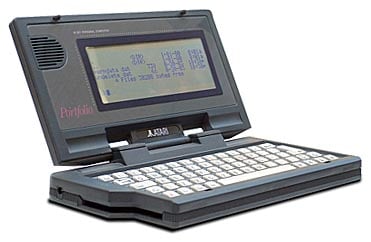This article is more than 1 year old
Atari's Portfolio: the world's first palmtop
18 years before Palm's Foleo...
Forgotten Tech There's nothing new under the sun, some folk say, and that's certainly true of Palm's recently announced Foleo. It's the palmtop reborn in a slightly sexier, slightly larger form. Even its name is reminiscent of that bygone arena - it's rather like the Atari Portfolio, the world's first palmtop PC, released in June 1989.

Atari's Portfolio: a rebranded DIP Pocket PC
Atari's compact clamshell ran an MS-DOS compatible operating system - DIP-DOS, from Guildford-based Distributed Information Processing (DIP) Systems - on a 4.92MHz Intel 80C88 processor. The Portfolio has 128KB of memory on board, 32KB of which was reserved for data storage, exposed as the C: drive and backed up by the three AA batteries the Portfolio ran from. A built-in long-life cell protected the memory when the batteries needed changing.
The Portfolio's display was a 40-character by eight-line job with a 240 x 64-pixel graphics mode, mounted next to the unit's speaker and above the calculator-style QWERTY keypad. A slot on the side took a range of device-specific memory cards running from 32KB to 128KB.
Anticipating Palm's own Pilot - which shipped in April 1996, seven years after Atari first showed its palmtop - the Portfolio had diary and address book applications, along with a basic word processor and a spreadsheet package. The apps and the OS resided in 256KB of ROM. Plenty of space, you might think, for programming tools, but the Portfolio had none, not even a Basic language interpreter. To be fair, this wasn't a machine aimed at coders but at the growing number of folk who wanted a computer for information storage and retrieval, a feature Palm was later to major on with the Pilot. In any case, programming tools were later offered as add-ons.

Atari's Portfolio: expandable
Unlike the Pilot and, now, the Foleo, the Portfolio was designed to operate on its own, independently of a desktop machine or other device. That said, data could be transferred back and forth between the palmtop and a desktop, via a cable connected to the Portfolio's add-on parallel port.
Incidentally, movie buffs may recall an Atari Portfolio was the device the young John Connor used to hack an ATM in Terminator 2.
